
Mindfulness Practices
Find out what mindfulness is and how meditation affect your brain, stress, and energy levels.
Home » Meditation » Breathing Practices

Breathing exercises have long been hailed by yoga practitioners as miraculous practices that help people quiet the mind, focus, and even alleviate pain.
A growing body of research shows that the yogis are on to something — many breathing practices have been shown to reduce blood pressure, activate parts of the nervous system that help you relax, and even normalize brain waves.
Breathing practices are used by doctors and therapists worldwide. Studies show that breathing techniques can help reduce stress hormone levels in the brain, alleviate anxiety and depression, and lower blood pressure. Stanford researchers have found that breathing practices reduce PTSD in veterans, and people with COPD use them to improve airflow & boost their capacity for exercise.
If you haven’t incorporated breathing exercises in your routine, these are all great reasons to start. Here’s a list of science-backed breathing practices to help you get through the day with illustrations. You can download them here to always have them with you and use in every situation.
Feeling sluggish and have no idea how to get over that mid-day slump? There are two breathing tactics to help you out.
Research from Hunter Pain Clinic and ATUNE Health Centers in Australia shows that karate breathing helps enhance ventilation efficiency, increase cardiac output, and synchronizes blood pressure pulse fluctuations with your blood pressure rhythm — effects that will leave you feeling ready to tackle the rest of your long report.
Here’s how to do it:
Sit with your legs beneath the buttocks and knees directly in front, cross-legged or in another position that’s more comfortable. Close your eyes, but keep your back straight, shoulders relaxed, head up, your eyes (behind your lids) focused ahead.
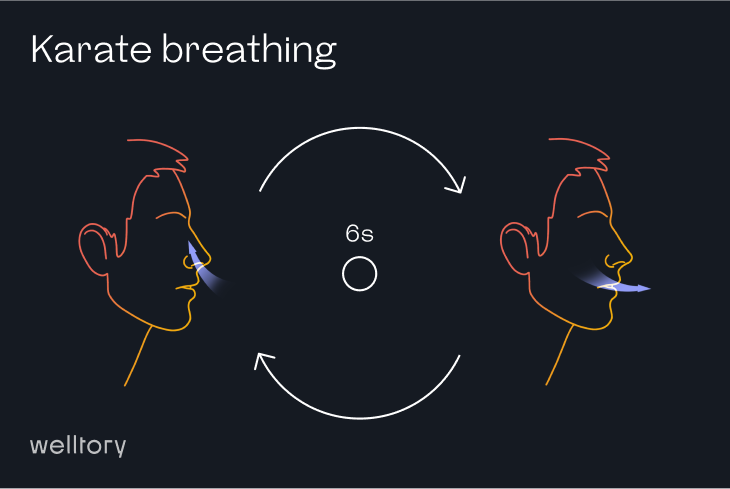
Then, follow these steps:
1. Take a deep, cleansing breath, expanding your belly and keeping your shoulders relaxed, and hold it in for the count of six.
2. Exhale, and repeat twice more.
3. Then breathe normally, and focus your attention on your breathing. As you breathe, inhale through your nose and exhale through your mouth, still expanding your belly rather than moving your shoulders up and down.
Continue for as long as you like.
Important: Don’t do this before going to sleep. It will keep you up way past your bedtime!
It has been shown by Researchers from the Department of Physiology at Nepal College to decrease blood pressure and heart rate, balancing the nervous system and helping you feel energized.
Here is how to do it:
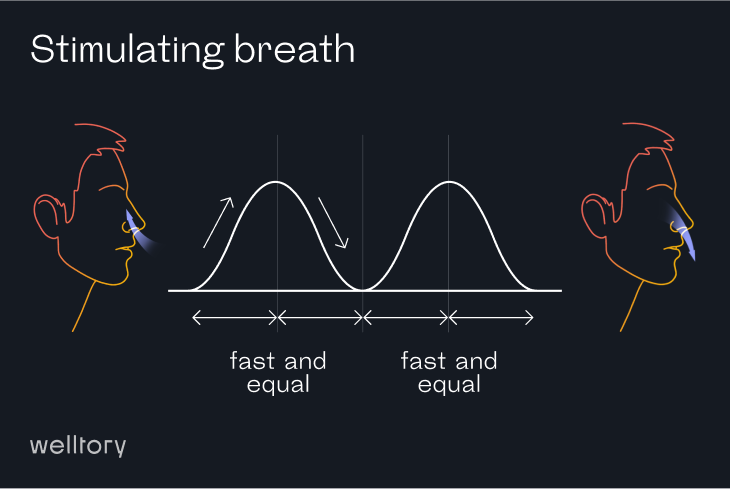
Sit comfortably with your back straight.
Then, follow these steps:
1. Inhale and exhale rapidly through your nose.
2. Try to keep your mouth shut and as relaxed as possible.
3. Aim to keep your inhales and exhales equal in duration but as reduced as possible.
Repeat for as long as you like.
If you feel extreme anxiety or panic attack coming on (or you’re already in the middle of one), there are two techniques you can try.
It is a kind of diaphragmatic breathing that has been shown by researchers from Beijing Normal University to reduce negative subjective and physiological consequences of stress in healthy adults.
Important: Don’t do this exercise if you have a heart condition.
Here’s how to do it:
Sit with your back straight, but try to be comfortable
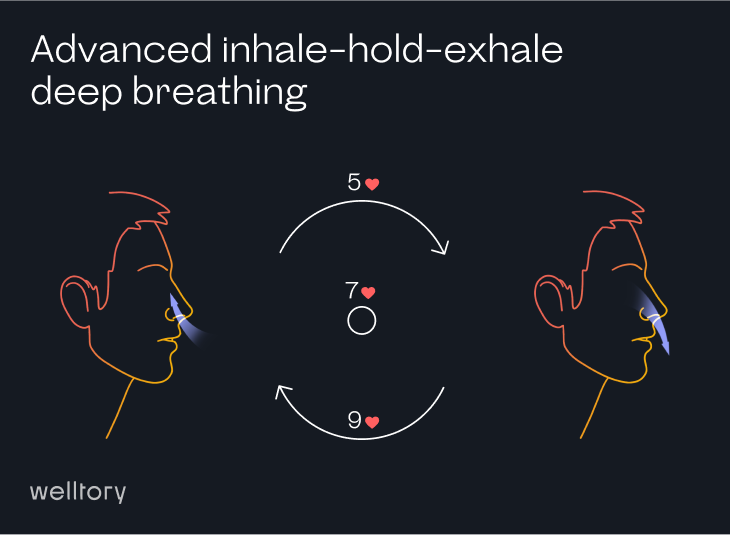
Then, follow these steps:
1. Inhale and count 5 heartbeats
2. Hold your breath and count 7 heartbeats
3. Exhale and count 9 heartbeats
Do at least 10 cycles, but go longer if you need to.
It is a slow-paced breathing technique that has been shown to enhance stress management.
Here’s how to do it:
Just sit comfortably with your back straight.
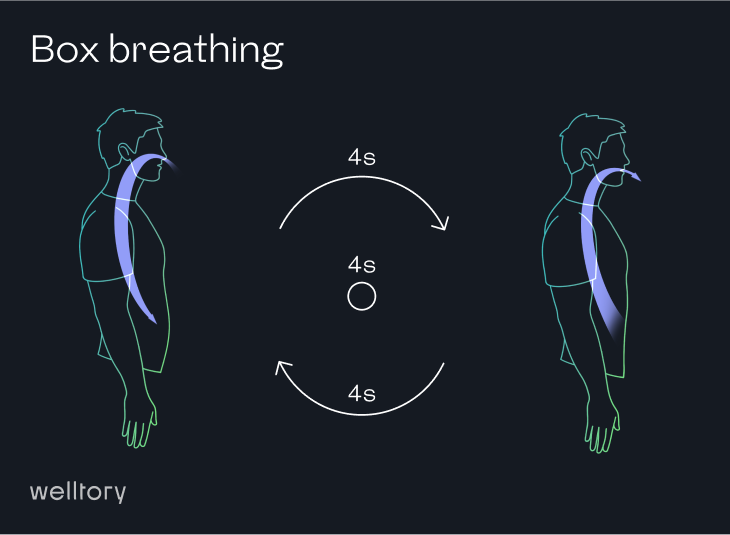
Then, follow these steps:
1. Breath in through your nose filling up your belly for 4 seconds
2. Hold for 4 seconds
3. Exhale through your mouth for 4 seconds
4. Hold for 4 seconds
Repeat for 4 cycles, or longer is you need to.

If you’re generally stressed or anxious and are looking for a way to turn down the heat, these two practices should help.
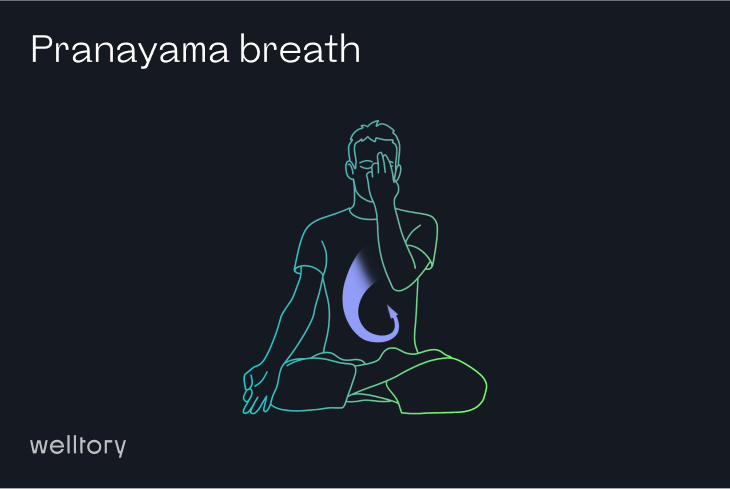
Then, follow these steps:
1. Breathe only through your nostrils. Begin by simply observing the natural flow of your breath and let go of any thoughts.
2. Inhale slowly and with purpose, drawing your breath deep into the lower abdomen, starting from the pelvic floor and slowly allowing the breath to fill upward (toward the navel) and outward (away from the spine).
3. As the breath fills this area, allow it to expand outward in all directions — to the front (expanding the lower belly), to the sides (expanding the hips), and to the back (expanding the lumbar spine and the sacrum) — as it moves upward toward the navel.
4. Once the lower abdomen has filled completely, continue the inhalation by filling the mid-torso in a similar manner.
5. Once the mid-torso feels full, complete the inhalation by drawing the breath into the upper chest — allowing prana to rise up into the heart, the sternum, and finally into the shoulders and the base of the neck. Feel the collarbones lift slightly.
Repeat for as long as it takes to calm down.
Like Pranayama, it activates the parasympathetic part of the nervous system, which helps you relax.
Here’s how to do it:
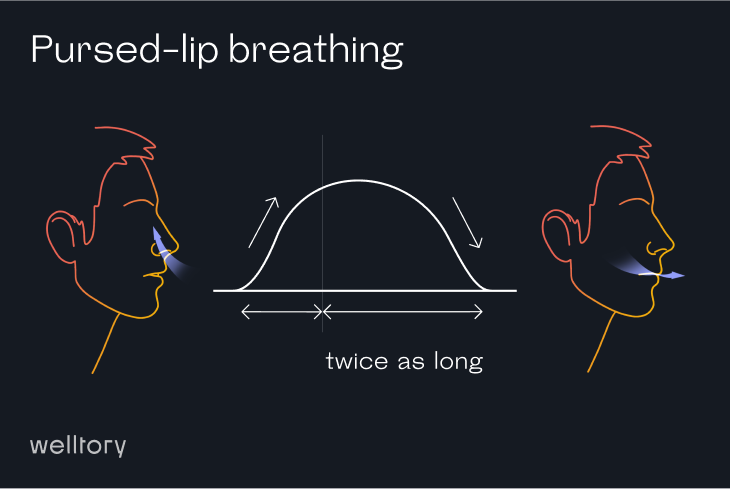
To start, sit comfortably with your back straight.
Then, follow these steps:
1. Inhale slowly through your nostrils.
2. Purse your lips, as if pouting or about to blow on something.
3. Breathe out as slowly as possible through pursed lips. This should take at least twice as long as it did to breathe in.
You can continue doing this for as long as you like.
If you’re one out of the 60 million Americans struggling with insomnia, there are breathing techniques that can help knock you out.
It is a technique that can reset your autonomic nervous system and help you sleep, according to a study by the Augusta Women’s Center.
Here’s how to do it:
Sit comfortably with your back as straight as possible. Place the tip of your tongue behind your upper front teeth where they meet the gum ridge. You will need to keep your tongue here for the duration of the technique.
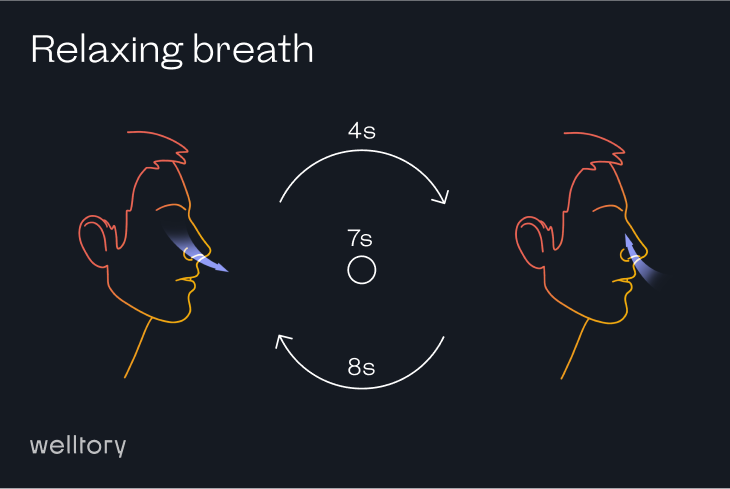
Then, follow these steps:
1. Start by exhaling fully. Usually, because of where your tongue is placed, this would make a natural “whoosh” sound.
2. Inhale quietly for a count of four.
3. Once reached, hold your breath here for a count of seven and then exhale fully for a count of eight.
Take four to five complete breaths to relax.
It will activate your body’s rest-and-digest system so you have a better chance at getting some shut-eye.
Here is how to do it:
For this practice, begin by lying on your back with your knees bent and feet flat on the floor, hip-width apart. Place a palm on the abdomen and take a few relaxed breaths, feeling the abdomen expand on the inhalation and gently contract on the exhalation.
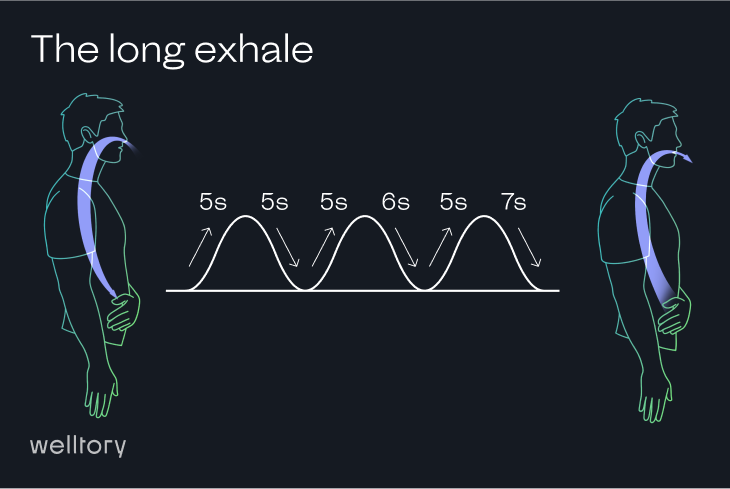
Here’s what to do next:
1. With your palm on your abdomen, count the length of each inhale/exhale for a few breaths. If it takes you longer to inhale, try to make them the same length over the next few breaths.
2. Once they’re equal, gradually increase the length of your exhalation by 1 to 2 seconds by gently contracting the abdomen.
3. As long as the breath feels smooth and relaxed, continue to gradually increase the exhalation by 1 to 2 seconds once every few breaths.
4. Make sure you experience no strain as the exhalation increases and keep going until your exhalation is up to twice the length of the inhalation, but not beyond.
Do this for as long as it takes
Bonus: The Long Exhale is also great for reducing stress, anxiety, heart rate, and even blood pressure.
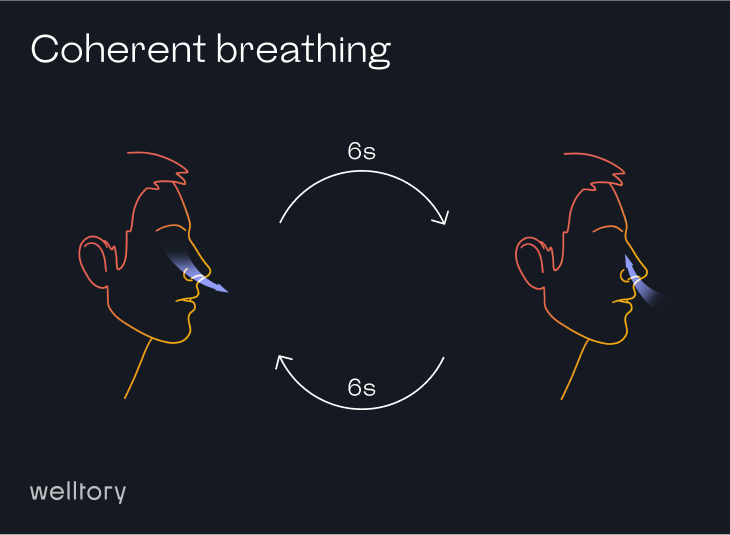
Repeat until you’re feeling better.
It is (also known as Sitali/Sitkari Pranayama) has a sort of cooling effect on the nervous system, and EEG scans have shown that it helps quiet the mind.
Here is how to do it:
Sit comfortably, either in a chair or on the floor, with your shoulders relaxed and your spine naturally erect. Slightly lower the chin, curl the tongue lengthwise, and project it out of the mouth to a comfortable distance.
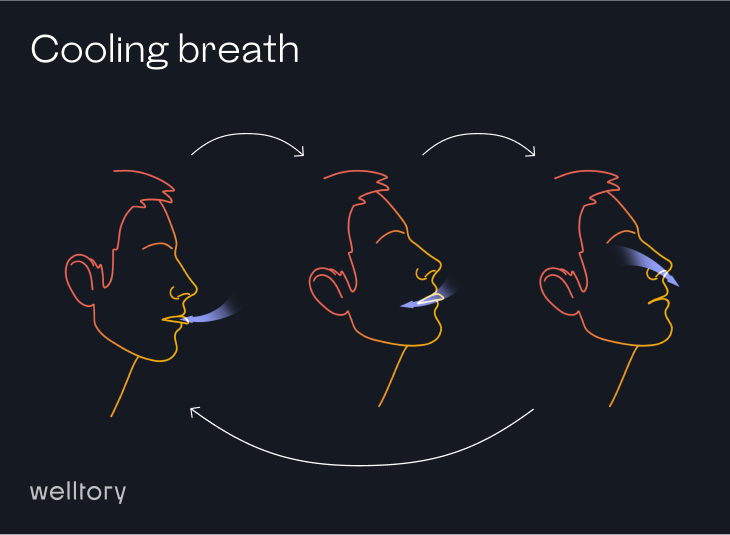
Then, do this:
1. Inhale gently through the “straw” formed by your curled tongue as you slowly lift your chin toward the ceiling, lifting only as far as the neck is comfortable.
2. At the end of the inhalation, with your chin comfortably raised, retract the tongue and close the mouth.
3. Exhale slowly through the nostrils as you gently lower your chin back to a neutral position.
Do 8–12 cycles to feel the effects.

It has been shown to reduce blood pressure and improve mood when practiced regularly for 3 months in a paper published by the European Journal of Pharmaceutical and Medical Research.
Here is how to do it:
To start, sit in a comfortable, cross-legged position such as easy pose, placing padding under your seat as necessary. If sitting on the floor isn’t possible, lie on your back or sit in a chair.
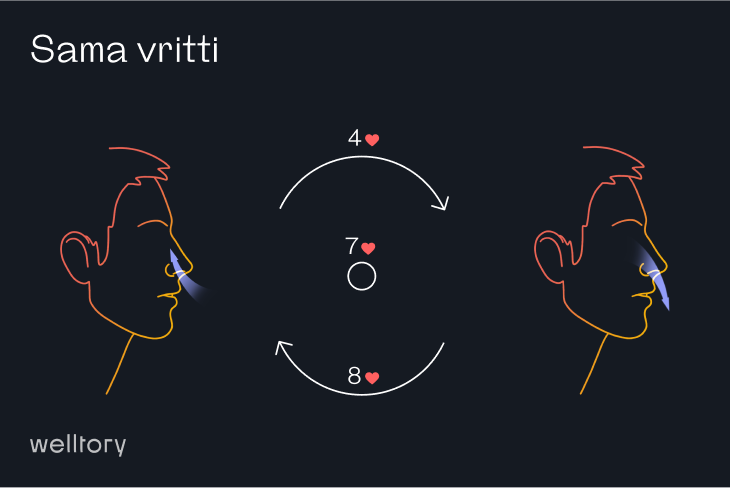
Then, do the the following:
1. Close your eyes and begin to notice your natural breath. Take five breaths or so.
2. Begin to slowly count to four as you inhale. Take a moment, then also count to four as you exhale.
3. Again, take a moment to feel empty. Then inhale again to another count of four.
You can experiment with changing the number you count to, but make sure you inhale and exhale for the same period of time. Continue breathing this way for several minutes.
Use Welltory to check how well these practices work for you.
There are three ways to see how a breathing practice affects your body.
The first is taking heart rate variability measurements right before and right after a breathing practice. This will give you an idea about the immediate effects of the exercise. If it works for you should help you reduce your stress score and boost your energy level.
Use a pre-set tag ‘Breathing exercises’ tag or create your own tag for each practice you try. After you’ve used the tag 3 times you can check how it affects your scores in the Charts tab in Measurement history under Your Boosters or Your Bummers.However, especially with exercises that have long-term stress reduction effects when practiced on a regular basis, you may also want to check how it affects your body over the long-term.
Here’s how:
1. Establish a morning baseline by taking measurements right after you wake up for 7 days in a row.
2. Introduce a new breathing practice into your routine for a couple of weeks, and continue taking morning measurements. If there are no other drastic changes to your lifestyle, you’ll be able to see how the practice affects your baseline stores over the long-term on the graphs in My Data tab. If the practice is benefiting you, you should see a gradual decline in your Stress levels, along with higher Energy and Performance scores.
Welltory Team, 23 Dec. 2021

Find out what mindfulness is and how meditation affect your brain, stress, and energy levels.
 App Store
App Store
 Google Play
Google Play
 Huawei AppGallery
Huawei AppGallery
 Galaxy Store
Galaxy Store







